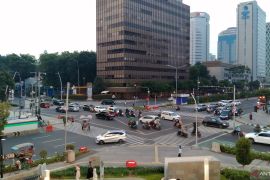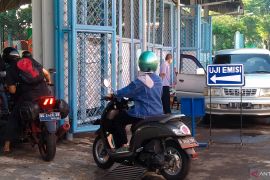Jakarta’s weather felt different in the past two weeks without any cool morning air greeting residents.
The sun's rays were not able to penetrate to the city and the sky looked grey, with no clear blue patches or clouds.
The grey sky did not indicate rain since there was no roar of thunder. Rather, it was a sign of the level of smoke blanketing the capital and its current air quality.
Jakarta's air quality periodically experiences an increase in air pollutant concentrations at the start of the dry season in May–August, which usually decline in the rainy season from September–December.
A decrease in air quality during the dry season has been recorded in the period from 2019 to 2023 based on trends in PM2.5 concentrations. PM or particulate matter are airborne particles that are smaller than or equal to 2.5 µm (micrometer) in size.
The monthly average concentration of PM2.5 has increased from 29.75 mg/m3 in April to 50.21 mg/m3 in May. However, this concentration was still lower compared to May 2019 before the pandemic hit, when it was recorded at 54.38mg/m3.
According to the Jakarta Environment Agency (DLH), the biggest sources of air pollution in the city are its industrial and transportation sectors.
Sources of emissions from an area affect other areas due to the movement of pollutants from one location to another due to wind patterns. This can potentially trigger an increase in pollution in other locations.
Based on data from the DLH, there are seven types of pollution or pollutants being studied in Jakarta.
The biggest source of SO2 (sulfur dioxide) pollution is the industrial sector, which contributes 61.96 percent or 2.637 tons, then power plants, which account for 25.16 percent or 1.071 tons of SO2, followed by the transportation sector, which adds 11.58 percent or 493 tons of SO2.
The transportation sector dominates in terms of its contribution of the pollutants NOx (nitrogen oxides), CO (carbon monoxide), PM10 (particulate matter), PM2.5 (particulate matter), BC (black carbon), and non-methane volatile organic compounds (NMVOC).
The transportation sector accounts for 72.4 percent or 76,793 tons of NOx, 96.36 percent or 28,371 tons of CO, 57.99 percent or 5,113 tons of PM10, 67.04 percent or 5,257 tons of PM2.5 pollutants, 84.48 percent or 5,048 tons of BC, and 98.5 percent or 19,936 tons of NMVOC.
Besides the transportation sector, the biggest contributors of CO in Jakarta are power plants (1.76 percent or 5,252 tons), followed by the industry sector (1.25 percent or 3,738 tons), housing sector (0.59 percent or 1,774 tons), and the commercial sector (0.03 percent or 90 tons).
Jakarta's air quality has also been affected by emission sources during the post-COVID-19 pandemic period since increased public mobility has pushed up emissions.
Air quality is also influenced by meteorological factors such as rainfall, wind speed and direction, and air humidity.
Rain can help pollutants floating in the air to evaporate; however, the low wind speed in Jakarta causes stagnation of air movement, causing air pollutants to accumulate at some points.
Trapped air can also trigger the production of other air pollutants, such as surface ozone (O3), whose presence can be determined by reduced visibility.
The surface wind direction pattern shows the movement of air masses from the east and northeast toward Jakarta and has an impact on the accumulation of PM2.5 concentrations.
Lastly, high humidity can cause the appearance of an inverse layer near the surface. Inverse is a layer in the air that is characterized by an increase in air temperature as the layer height increases.
The impact of this inverse layer causes PM2.5 on the surface to remain suspended, unable to move to other air layers, resulting in an accumulation of its concentration, which can be measured by a monitoring device.
Related news: Jakarta Environment Office to install three air quality monitors
Related news: Jakarta promotes EV use to check pollution
Air quality control
Based on IQAir data, as of 12:05 p.m. local time on Monday (June 12, 2023), air quality in Jakarta was the second worst among cities in the world at US 156 AQI after Hanoi, Vietnam, which recorded a level of US 157 AQI.
In response, DLH took seven measures to deal with air pollution in the capital city, as outlined in the Governor Instruction Number 66 of 2019 concerning air quality control.
The measures included the rejuvenation and testing of public and private vehicle emissions, implementing odd-even vehicle plates, imposing parking rates, congestion pricing, limiting the age of vehicles allowed to ply on the roads, changing modes of transportation, and improving pedestrian comfort and facilities.
The measures to tackle industrial pollutants took the form of imposing controls on the industrial sector, reforesting public facilities and infrastructures, as well as converting to renewable energy.
In addition, Governor Regulation Number 66 of 2020 concerning motor vehicle exhaust emission tests has been issued to control emissions from vehicles. A grand design for controlling air pollution was prepared last year and will be included in the Governor's Decree on the Air Pollution Control Strategy (SPPU).
Head of the Jakarta Environment Agency, Asep Kuswanto, said that his agency is also working closely with academics, practitioners, and related non-governmental organizations (NGOs) to compile regulatory reviews.
The provincial government will also open more green open spaces (RTH) and support the use of electric-powered vehicles in the capital city so that air pollution in the area, which has a population of more than 11 million, can be controlled.
Moreover, the Jakarta Health Service has also continued to optimize health services at healthcare facilities to reduce the risk of disease transmission due to Jakarta's unhealthy air.
The health services cover promotive (health improvement), preventive (disease prevention), curative (disease healing), and rehabilitative (health recovery) programs.
Related news: Jakarta optimizes health services to reduce pollution-related diseases
Related news: Jakarta seeks to improve air quality through bus electrification
Translator: Siti Nurhaliza, Resinta S
Editor: Sri Haryati
Copyright © ANTARA 2023












